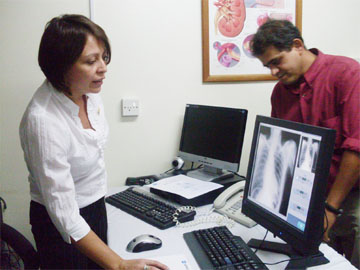-will aid early detection of breast cancer
The Radiology Department at the Woodlands Hospital Limited yesterday launched its $40M state-of-the-art Computer Radiographic and Mammogram Units.
These are the first of their kind in Guyana.
Doctor Neville Gobin, Director of the Woodlands Hospital Board, said the equipment will benefit the entire country. Breast cancer, Gobin noted, is the most common form of cancer among women in Guyana and he stressed that the earlier this form of cancer is detected in women the better their chances of survival. The computer based digital mammogram unit will enable doctors to make earlier prognoses and administer treatment before the disease reaches a far more advanced stage, Gobin pointed out.
“The equipment cost about $40 million,” he said, while crediting Trust Company Guyana Limited for making the venture possible.
He also said that the use of this new technology will not burden the pockets of patients. Mammograms which currently cost $6,500 will see a $500 increase while other forms of x-rays will remain at their original prices.
Computer Radiography (CR) is a more efficient, inexpensive and environmentally friendly method of acquiring x-ray images in a digital format. The traditional film-screen system previously employed at Woodlands is being rapidly replaced by CR systems worldwide which increase the accuracy with which doctors must do their work.
At the launch, Alicia Barabas, a Clinical Health Care Specialist from the CASI Company in Trinidad, from which the equipment was procured, attempted to simplify the entire CR process and its benefits to both doctors and patients. She explained that the entire system is computer-based. After the x-ray is taken the image is then transferred to a workstation (computer) attached to the system where it can be viewed in real time by the radiologist.

The radiologist can then manipulate that image on a high resolution screen with zoom and flip capability which will enable then to better assess the image they are examining. Further, the system compensates automatically for exposure variations therefore patients will not have to be called in for retakes.
Perhaps the most important advantage of the CR system is the fact that it is well suited to emergencies where time is crucial and patient cooperation is limited. “The system reduces examination time which means doctors can solve the problem faster,” Barabas stated.
